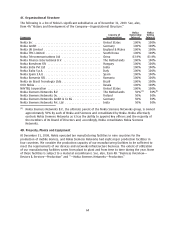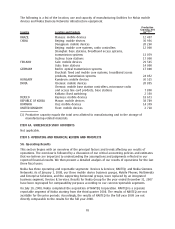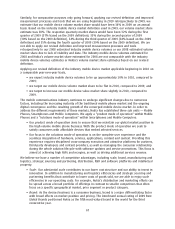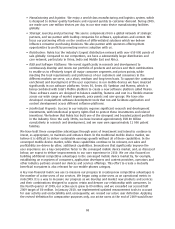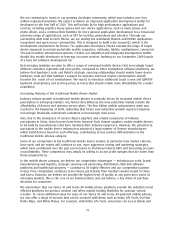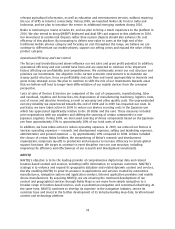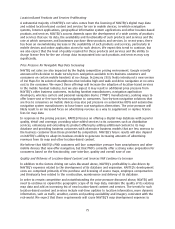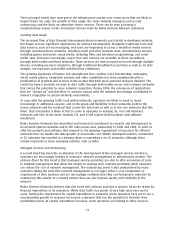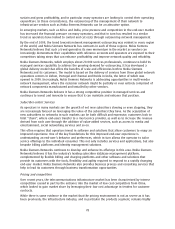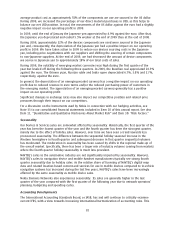Nokia 2009 Annual Report Download - page 75
Download and view the complete annual report
Please find page 75 of the 2009 Nokia annual report below. You can navigate through the pages in the report by either clicking on the pages listed below, or by using the keyword search tool below to find specific information within the annual report.We are continuing to invest in our growing developer community, which now includes over four
million registered members. We expect to deliver an improved application development toolkit for
developers in the first half of 2010. This will include Qt for high performance applications and
services, including graphicsheavy games and core device applications, such as music player and
photo album, and a common Web Runtime for more general application development for a broad and
extensive range of applications, such as GPS for location, phonebook and calendar. Through our
partnership with Intel to form MeeGo, we are uniting the worldwide Maemo and Moblin applications
ecosystems and open source communities. This is designed to build scale around Qt, which is the
development environment for MeeGo. For application developers, MeeGo extends the range of target
device segments to include pocketable mobile computers, netbooks, tablets, mediaphones, connected
TVs and invehicle infotainment systems. Further, our simplified and integrated development toolkit
should also enable developers to leverage our open services, building on our September 2009 launch
of a beta Ovi software development kit.
By leveraging Symbian, we plan to offer a range of converged mobile devices that increasingly target
different consumer segments and price points. Compared to other smartphone software platforms, we
believe that Symbian’s scale and Nokia’s strategic sourcing relationships should enable lower device
hardware costs and that Symbian’s support for operator and local market customization should
broaden the reach of our smartphones. We expect to introduce additional touch screen and QWERTY
keyboard smartphones and to bring prices to levels that should enable more affordability for a wider
population.
Increasing Maturity of the Traditional Mobile Device Market
Industry volume growth in traditional mobile phones is primarily driven by increased mobile device
penetration in emerging markets. Key factors that influence the new subscriber market include the
affordability of devices and operator service plans. The four billion mobile subscriptions mark was
reached in the beginning of 2009, indicating that future new subscriber growth requires targeting
increasingly financially constrained customers in increasingly rural areas.
Also, due to the emergence of certain chipset suppliers and related ecosystems of industry
participants in China, entry barriers have been lowered. Such chipset suppliers enable mobile devices
to be built by manufacturers that have relatively little industry experience. However, the potential to
participate in the mobile device industry has attracted a large number of Chinese manufacturers
which build devices based on such offerings, contributing to less product differentiation in the
traditional mobile phones category.
Some of our competitors in the traditional mobile device market, in particular new market entrants,
have used, and we expect will continue to use, more aggressive pricing and marketing strategies,
which have contributed over the past several years to declining industry ASPs and increasing pressure
on profitability. These competitors may simply be willing to accept profit margins that are lower than
those targeted by us.
In the mobile phone category, we believe our competitive advantages — including our scale, brand,
manufacturing and logistics, strategic sourcing and partnering, distribution, R&D and software
platforms and intellectual property — continue to be highly effective and our competitive position
strong. Price competition continues to be robust, particularly from handset vendors based in China
and Korea. However, we believe we provide the highest level of quality at any given price point. In
emerging markets, this is the core of our brand promise and, we believe, a key driver of purchase
decisions for consumers.
We also believe that our Series 30 and Series 40 mobile phone platforms provide the industry’s most
efficient platforms for product creation and offers market leading flexibility for operator variant
creation. To create additional value for users of our Series 30 and Series 40powered mobile phones,
we also offer a range of services that can be accessed with them, such as Nokia Life Tools, Ovi Mail,
Nokia Maps, and Nokia Money. For example, with Nokia Life Tools, consumers can access timely and
73



